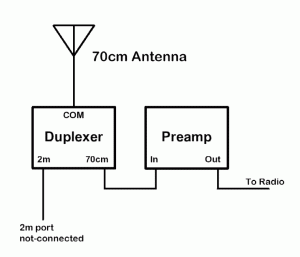A Simple Desense Filter for Mode-J Satellites
Background
If you have a hard time hearing your own downlink but have no trouble hearing other stations, you may be experiencing “desense.” Desense is where your transmitter signal overloads your preamp (or receiver) causing it to become temporarily less sensitive. This overload condition may also be accompanied by white noise or intermodulation distortion where you hear distorted signals in your receiver, including possibly your own transmit signal, but only when you are transmitting. If reducing your transmitter power clears up this condition, you are most likely experiencing desense. Desense problems can occur on any frequency and even commercial radio installations sometimes experience these problems, but it is especially common when transmitting on 2 meters and receiving on 70 cm to work mode-J satellites.
Several solutions exist and an easy one is to just reduce your transmit power. This may solve the problem but it will probably limit your ability to operate when satellite conditions are difficult such as near AOS or LOS or when the satellite transponder is especially busy.
Another way to solve this problem is to increase the separation of your 2 meter and 70cm antennas. This will always work if you get them far enough apart (10-20 feet) but it may not be practical for many stations.
A third solution is to install a high-pass or band-pass filter in-between the 70cm antenna and the preamp or receiver. An easy way to accomplish this is to use a 2m/70cm duplexer. Note that technically these devices are diplexers but nearly all hams and ham radio manufacturers call them “duplexers.” A typical device provides 60dB of rejection betwen the 2-meter and 70cm ports and this is generally sufficient to eliminate a desense problem.
Hooking it Up
Connecting the Duplexer
The COMET CF-416C duplexer works very well in this application and is highly recommended. It has a an N-female connector for the “mix” port and includes a short coax pigtail terminated with an N-male connector for the 70cm port. It is important to make sure to connect the duplexer mix port to the antenna and the 70cm pigtail port to the preamp. Otherwise, any stray pickup on the 2m lead will be sent un-attenuated to the preamp and you may still experience desense problems. Since most 70cm antennas and preamps come with N-female connectors, you can just disconnect your existing coax lead from the preamp and re-connect it onto the N-female mix (or “common”) connector on the duplexer. Then you connect the 70cm pigtail lead from the duplexer to the preamp.
The 2m port from the CF-416C comes with a short coax pigtail and a PL-259 (male) connector and this can be left un-terminated as it has no affect on the 70cm side. It can be taped to your tower or mast and should be left with the connector facing towards the ground as you do not want water running down the lead and into the duplexer. Also note that most duplexers are not water-tight so you may need to put it into a weatherprooof box or seal the unit with an outdoor waterproofing compound such as “Marine GoopTM.”
Besides Comet, there are several manufactures including Diamond, MFJ, and Yaesu that make suitable units with a variety of connector arrangements so you have a lot choices to customize the installation for your particular situation. Make sure the unit you choose has at least 60db of suppresion between the 70cm and 2m ports and be sure to connect the “COMMON” port towards the antenna.
Testing
It is easy to test the filter without waiting for a satellite pass. Tune in a distant 70cm repeater or just point your beam away from a local one and then transmit into the 2m antenna at full power. With the duplexer installed, the 70cm received signals should be clean with no noise, interference or loss of sensitivity as a result of operating the 2m transmitter.
If the duplexer does not completely clear up the desense issue, then overload is not your only problem. In this event, check all coax, antenna and mast connections to insure that they are nice and tight with no corrosion visible on any connections or fasteners. Especially difficult desense problems can be caused by poor or corroded electrical or mechanical connections.
Summary
The use of a 2m/70cm antenna duplexer to clear up a Mode-J desense problem has been employed by many satellite operators and it works! Even when the antennas are close together and 100 watts or more are applied to the 2-meter antenna, the 60dB of rejection provided by the duplexer should clear up any desense problem.
Article submitted by Anthony Monteiro, AA2TX

